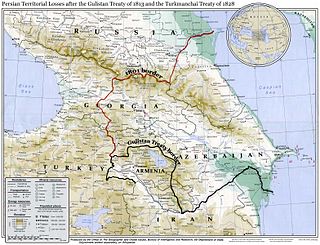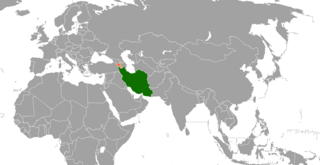Related Research Articles

Gilan province is one of the 31 provinces of Iran. It lies along the Caspian Sea, in Iran's Region 3, west of the province of Mazandaran, east of the province of Ardabil, and north of the provinces of Zanjan and Qazvin. It borders Azerbaijan in the north.

The Treaty of Gulistan was a peace treaty concluded between the Russian Empire and Iran on 24 October 1813 in the village of Gulistan as a result of the first full-scale Russo-Persian War. The peace negotiations were precipitated by the successful storming of Lankaran by General Pyotr Kotlyarevsky on 1 January 1813. It was the first of the series of treaties signed between Qajar Iran and Imperial Russia that forced Persia to cede the territories that formerly were part of Iran.

The Treaty of Turkmenchay was an agreement between Qajar Iran and the Russian Empire, which concluded the Russo-Persian War (1826–1828). It was second of the series of treaties signed between Qajar Iran and Imperial Russia that forced Persia to cede or recognize Russian influence over the territories that formerly were part of Iran.

Tahmasp II was the penultimate Safavid shah of Iran, ruling from 1722 to 1732.

The Karabakh Khanate was a khanate under Iranian and later Russian suzerainty, which controlled the historical region of Karabakh, now divided between modern-day Armenia and Azerbaijan. In terms of structure, the Karabakh Khanate was a miniature version of Iranian kingship. The administrative and literary language in Karabakh until the end of the 19th century was Persian, with Arabic being used only for religious studies, despite the fact that most of the Muslims in the region spoke a Turkic dialect.
The Russo-Persian Wars or Russo-Iranian Wars were a series of conflicts between 1651 and 1828, concerning Persia (Iran) and the Russian Empire. Russia and Persia fought these wars over disputed governance of territories and countries in the Caucasus. The main territories disputed were Aran, Georgia and Armenia, as well as much of Dagestan – generally referred to as Transcaucasia – and considered part of the Safavid Iran prior to the Russo-Persian Wars. Over the course of the five Russo-Persian Wars, the governance of these regions transferred between the two empires. Between the Second and Third Russo-Persian Wars, there was an interbellum period in which a number of treaties were drawn up between the Russian and the Persian Empires, as well as between both parties and the Ottoman Empire. Ottoman interest in these territories further complicated the wars, with both sides forming alliances with the Ottoman Empire at different points throughout the wars. Following the Treaty of Turkmenchay, which concluded the Fifth Russo-Persian War, Persia ceded much of its Transcaucasian territory to the Russian Empire.
Russo-Turkish wars or Russo-Ottoman wars were a series of twelve wars fought between the Russian Empire and the Ottoman Empire between the 16th and 20th centuries. It was one of the longest series of military conflicts in European history. Except for the war of 1710–11, as well as the Crimean War which is often treated as a separate event, the conflicts ended disastrously for the Ottoman Empire; conversely, they showcased the ascendancy of Russia as a European power after the modernization efforts of Peter the Great in the early 18th century.

Relations between the Grand Duchy of Moscow and the Persian Empire (Iran) officially commenced in 1521, with the Safavids in power. Past and present contact between Russia and Iran have long been complicatedly multi-faceted; often wavering between collaboration and rivalry. The two nations have a long history of geographic, economic, and socio-political interaction. Mutual relations have often been turbulent, and dormant at other times.

The Russo-Persian War of 1722–1723, known in Russian historiography as the Persian campaign of Peter the Great, was a war between the Russian Empire and Safavid Iran, triggered by the tsar's attempt to expand Russian influence in the Caspian and Caucasus regions and to prevent its rival, the Ottoman Empire, from territorial gains in the region at the expense of declining Safavid Iran.

The Russo-Persian War of 1826–1828 was the last major military conflict between the Russian Empire and Persia.

Bilateral relations exist between Armenia and Iran. Despite religious and ideological differences, relations between the two states remain extensively cordial and both are strategic partners in the region. Armenia and Iran are both neighbouring countries in Western Asia and likewise share a common land border that is 44 kilometres (27 mi) in length.

The khanates of the Caucasus, also known as the Azerbaijani khanates, Persian khanates, or Iranian khanates, were various administrative units in the South Caucasus governed by a hereditary or appointed ruler under the official rule of Iran. The title of the ruler was khan, which was identical to the Ottoman rank of pasha. Following the assassination of Nader Shah in 1747, internal chaos erupted in Iran, particularly in the South Caucasus, where semi-autonomous khanates emerged as a result of the lack of a centralized government. The khans neither had territorial or religious unity, nor an ethnic/national identity. They were mostly interested in preserving their positions and income.
The Treaty of ConstantinopleRusso-Ottoman Treaty or Treaty of the Partition of Persia was a treaty concluded on 24 June 1724 between the Ottoman Empire and the Russian Empire, dividing large portions of the territory of mutually neighbouring Safavid Iran between them.

Gīlān is an Iranian province at the southwestern coast of the Caspian Sea. This articles discusses its history.

The Derbent Khanate was a Caucasian khanate that was established in Afsharid Iran. It corresponded to southern Dagestan and its center was at Derbent.

Qajar Iran, also referred to as Qajar Persia, the Qajar Empire, Sublime State of Persia, officially the Sublime State of Iran and also known as the Guarded Domains of Iran, was an Iranian state ruled by the Qajar dynasty, which was of Turkic origin, specifically from the Qajar tribe, from 1789 to 1925. The Qajar family took full control of Iran in 1794, deposing Lotf 'Ali Khan, the last Shah of the Zand dynasty, and re-asserted Iranian sovereignty over large parts of the Caucasus. In 1796, Agha Mohammad Khan Qajar seized Mashhad with ease, putting an end to the Afsharid dynasty. He was formally crowned as Shah after his punitive campaign against Iran's Georgian subjects.
The Treaty of Saint Petersburg of 23 September [O.S. 12 September] 1723 concluded the Russo-Persian War of 1722-1723 between Imperial Russia and Safavid Iran. It ratified Iran's forced ceding of its territories in the North Caucasus, South Caucasus, and contemporary mainland Northern Iran, comprising Derbent (Dagestan), Baku, the respective surrounding lands of Shirvan, as well as the provinces of Gilan, Mazandaran, and Astarabad. The treaty further specified that the Iranian king would receive Russian troops for domestic peacekeeping.
Peter the Great's capture of Rasht, occurred between December 1722 and late March 1723 amidst the successful spree of campaigns of Peter the Great during the Russo-Persian War (1722-1723). The capture of Rasht brought the Caspian Sea town alongside the rest of Gilan into Russian possession for a decade, until the Treaty of Resht of 1732, when they would be returned.

The Iran–Turkey border is 534 kilometres in length, and runs from the tripoint with Azerbaijan in the north to the tripoint with Iraq in the south.

The Armenia–Turkey border is 311 km in length and runs from the tripoint with Georgia in the north to the tripoint with Azerbaijan in the south. The land border has been closed since 3 April 1993. The border is set to reopen for diplomats and citizens of third countries in 2023.
References
- ↑ THE CAUCASUS IN THE SYSTEM OF INTERNATIONAL RELATIONS: THE TURKMANCHAY TREATY WAS SIGNED 180 YEARS AGO Научная библиотека КиберЛенинка p 142
- ↑ William Bayne Fisher, P. Avery, G. R. G. Hambly, C. Melville. The Cambridge History of Iran, Volume 7 Cambridge University Press, 10 okt. 1991 ISBN 0521200954 p 21
- ↑ THE CAUCASUS IN THE SYSTEM OF INTERNATIONAL RELATIONS: THE TURKMANCHAY TREATY WAS SIGNED 180 YEARS AGO Научная библиотека КиберЛенинка p 142
![]() Media related to 1723 in the Russian Empire at Wikimedia Commons
Media related to 1723 in the Russian Empire at Wikimedia Commons